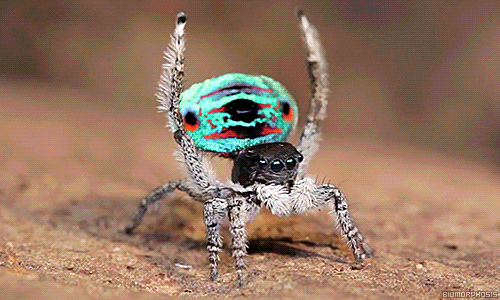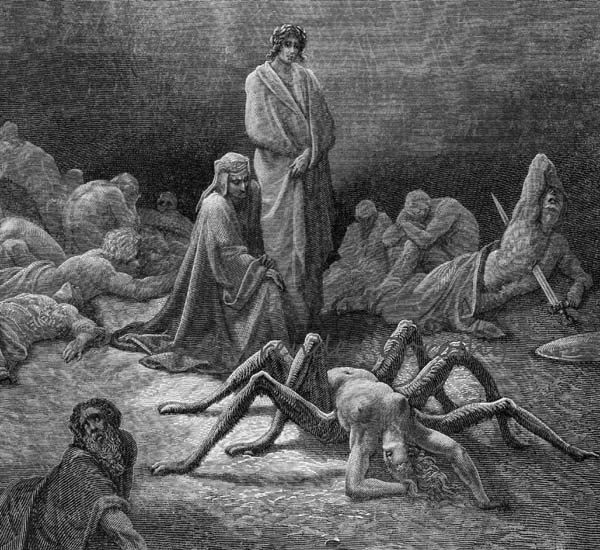By The Landlord
The Spider as an Artist
Has never been employed,
Though his surpassing Merit
Is freely certified,
By every Broom and Bridget
Throughout a Christian Land,
Neglected Son of Genius
I take thee by the Hand. – Emily Dickinson (1896)
Sometimes you’ve got to face your fears and phobias. I’m not sure, like Emily Dickinson, I’d go quite so far as “take thee by the hand”, but nevertheless this week it’s time to wander across a web of intrigue with songs about and inspired by this amazing arachnid – the reactions they can cause in us, their modes of behaviour, their extraordinary skills, their wide variety of colours and shapes. For their relatively tiny size they have a great power over us.
Like many people, I have a slight, irrational arachnophobia that comes and goes. It gradually diminishes the more I see of them, the more contact I have with them, and then the more I know about them, the more I like them. I think that’s a lesson for life. But unless you live in Australia (our readers over there will no doubt have plenty to offer on this), or other more tropical climates, most of us have little or nothing to fear. Our skin-creep reaction is some hardwired response from our distant African-terrain or tropical past.
Yet spiders, all of which have eight legs, and mostly eight eyes, are our household friends. They catch flies and other insects that can spread disease. There are 38,000 known species of spiders, on every continent except Antarctica and they are vital to a healthy ecosystem. They eat harmful insects, pollinate plants, and recycle dead animal and plants back into the earth. They are also a valuable food source for many small mammals, birds, and fish. There’s an estimated 1 million spiders live in one acre of land but far more in the tropics.
At my house, around very Christmas time an increasingly large house spider (could it still be the same one?) decides to take a jaunt from its home near the fireplace, have a look around, and with a swagger not unlike the style of Ian Brown from The Stone Roses, stomp across living room carpet and back again. So bold and large is (s)he that not even the cats dare chase him (or her).
Spiders are a reflection of our behaviour and how we see ourselves, our paranoias and self-consciousness. Singer Katie Melua famously went to a doctor after she heard a “shuffling” in her ear. The doctor discovered that a jumping spider was living in there thought to have climbed into earbud earphones she had used on a flight the previous week. Did it help her songwriting? Probably not. Did it increase record sales? Definitely.
The most notorious and famous spiders are species such as the black widow. “Madonna's like a black widow spider. She tends to use people, then they shrivel up and disappear,” said the former Joy Division and New Order cocky bass player Peter Hook. It’s the most obvious species that have songs about relationships. Black widows are indeed manipulative and scary. They are even known to eat males even while during mating process. The poison attacks nerves by blocking their signals to the muscles, which causes the muscles to contract repeatedly and often painfully and their bites can also cause other nerve-related problems, such as high blood pressure, restlessness, and severe facial spasms. Sounds like a bad relationship indeed.
However, the black widow is not necessarily the deadliest. The Brazilian wandering spider is the most aggressive, and as well as other nasty effects, its bite can cause long and painful erections in male victims. There’s a bit of a theme here. Perhaps spiders above all are a reflection of male phobias. Meanwhile you really don’t want to ever encounter the Sydney funnel-web spider, or six-eyed sand spider, which has excellent camouflage and could have the deadliest bit of all.
Tarantulas, big and hairy and undeniably scary in the way they move, are perhaps the other most famous species, and and interesting fact about them is during the 16th and 17th centuries, it was believed that a bite from this sub-species known as the wolf spider (named tarantula, from the Taranto region in Italy) would be deadly if the victim did not dance to a specific type of frenzied music. It inspired a dance called the tarantella. So just in case you’re feeling a little itchy now, let’s have a little dance:
But moving on from the nasties, my favourite species is the peacock spider, coming in different markings and colours, not only because they are very small, but because of their beautiful appearance and behaviour.
Say hello to the peacock spider, maratus personatus
… or the coastal peacock spider, maratus specosus
Here then let’s enjoy their dancey courtship rituals:
There are many fabulous eye-catching species and are fiendishly clever for hunting and other purposes, such as the yellow-striped wasp spider, with a body that mimics the colours of certain flowers, but with legs that invisible to insects. Or the visually alluring northern golden orb weaver, a big (20cm leg span) flower disguiser, that reflects lots of insect-friendly UV light. There’s the brown huntsman spider also known as the giant crab spider, with a white stripe, or "moustache", below its eyes, so reflective that it attracts moths. We can’t help also admire the the ghostly white orchid spider, or the many colours of the Brazilian crab spider, copying lots of flower varieties. Then there is the Hawaiian happy-face spider:
Or the Australian jewel spider:
Australian jewel spider
Or if you’re really looking for a really fancy show-off, how about the sequinned or mirrored spider.thwaitesia argentiopunctata?
Perhaps most spiders aren’t so scary until they move. It’s those wriggly legs that and multiple moving parts that perhaps trigger instinctive reactions in us to run away. But what we witness is a mechanical marvel. A spider’s muscles pull its legs inward, but cannot extend its legs out again. Instead, it must pump a watery liquid in a hydraulic system into its legs to push them out.
And yet like musical performers or athletes, it is often their movement that can make them also more attractive. Jumping spiders can leap up to 40 times their own body length, the equivalent of humans jumping over 230 feet. And it is also spiders’ ability to throw their silk and glides effortlessly across a three-dimensional space that is an even more dynamic update of Tarzan in the jungle, perhaps giving rise to the character of Spider-Man. And yet the latest actor playing this hero, Tom Holland, freely admits: It's quite difficult to take a superhero movie seriously because everything is heightened. A kid being bitten by a radioactive spider and getting superpowers is kind of ridiculous.” And yet look at how his costume copies the real thing:
Spider-Man. Facing fears and making spiders likeable?
So this week’s song suggestions could perhaps also take in other mythical spider humans and fictional creatures based on the species - giant or strange, such as Gustave Doré's illustration for an 1861 edition of Dante's Purgatorio, or the Japanese Jorōgumo ("prostitute spider") which is portrayed as being able to transform into a seductive woman, or the giant spider in Japanese folklore, Tsuchigumo.
Gustave Doré Arachné au purgatoire - expressing perhaps further sexual fears
But perhaps the most wondrous aspect of spiders is their ability to spin webs and how we perceive them. “It appears to me that almost any man may like the spider spin from his own inwards his own airy citadel,” said John Keats. “Laws are spider webs through which the big flies pass and the little ones get caught. Honore de Balzac. ”Look at spiders. They use about eight different properties of silk for different functions. The spider is like a multi-material 3D printer,” said American architect Neri Oxman. And their are indeed architectural masterpieces. Many are rebuild daily but some can last for years made from extraordinary material.
The silk that comes out of the spider’s spinneret is liquid, but it hardens as soon as it comes in contact with air. Some spiders have up to seven types of silk glands, each creating a different type of silk—such as smooth, sticky, dry, or stretchy. It is five times stronger than steal, and strand of spider silk is so light, that if one were wound around the entire world it would only weigh a pound. The Darwin bark spider creates the strongest material made by a living organism. Their giant webs can span rivers, streams, and even lakes and is 10 times stronger than Kevlar.
Orb webs are fantastically designed and flexible
Some webs are extremely intricate, not always purely functional, but this is not always the case. Some spiders, particularly the large family known as orb weavers, actively decorate their webs with extra silk designs known stabilimenta. St. Andrew’s cross spider weaves a special pattern that perhaps puts off bigger animals from running through the web, while still being able to catch flies.
St. Andrews cross spider and handiwork
On most orb webs, the threads that serve as spokes are stiffer and aren’t sticky. Once the structural supports are in place, the spider starts on the outside and spirals inward, attaching each segment of silk and coating the strands with a sticky substance. Even when flies get stuck on the web, this design generally maintains its strength, so the spider can make minor repairs rather than having to rebuild from scratch. Meanwhile funnel web types are more like a cave, a tunnel to catch prey and lead down to its burrow. And net-throwing spiders make a small silken web that they throw over their prey.
There are so many more amazing facts about spiders. They all have blue blood. The world’s biggest goliath spider growing up up to 11 inches wide with 1-inch fangs to hunt frogs, lizards, mice, and even small snakes and young birds. The smallest is the Patu marplesi –10 of them could fit on the end of a pencil.
But now it’s time to welcome back our very own special Spider Man to the Bar, the sensational swawilg, returning for a spin on the decks to select songs for selected playlists published next Wednesday. To weave in your songs suggestions into the possible mix, place them in comments below. Deadlines is 11pm on Monday UK time. Let’s get spinning
Jewels to be found on the web …
New to comment? It is quick and easy. You just need to login to Disqus once. All is explained i in About/FAQs ...
Fancy a turn behind the pumps at The Song Bar? Care to choose a playlist from songs nominated and write something about it? Then feel free to contact The Song Bar here, or try the usual email address. Also please follow us social media: Song Bar Twitter, Song Bar Facebook. Song Bar YouTube. Subscribe, follow and share.











